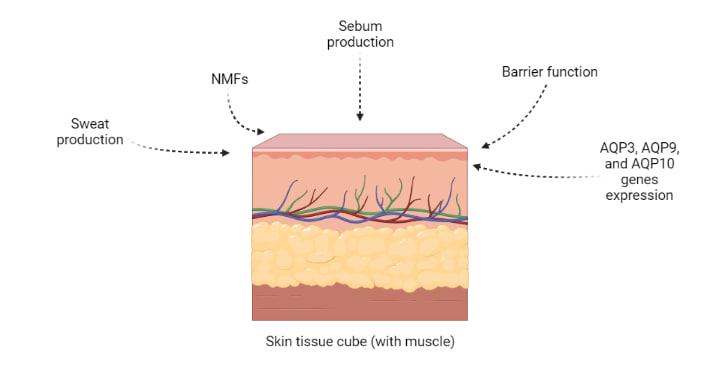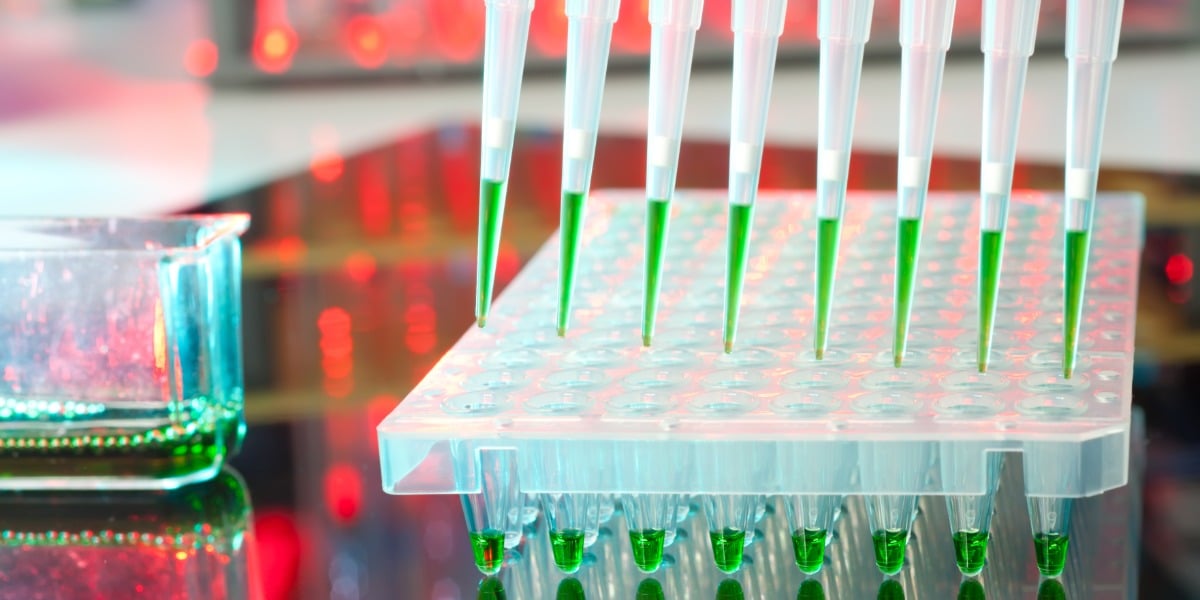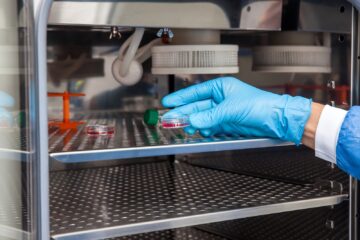Skin hydration is maintained by a complex set of physiological mechanisms that work together to ensure the skin retains the appropriate amount of moisture. These mechanisms involve both the skin’s barrier function and its natural moisturizing factors (NMFs).
Hydration efficacy can be provided by cosmetic products and is one of the main benefits sought by consumers. Its effectiveness depends directly on its ingredients, which can be validated for its moisturizing action through gene expression evaluation techniques.
In this article, we will explore the physiological mechanisms of hydration and techniques for validating the moisturizing efficacy of cosmetic ingredients through state-of-the-art gene expression evaluation techniques.
Physiological Mechanisms of Hydatrion
Skin hydration is composed of different connected physiological mechanisms, such as barrier function, NMFs, sebum production, and sweat production:
- Barrier function:
The barrier function of the skin is crucial for maintaining proper hydration levels. This function is primarily performed by the stratum corneum, the outermost layer of the epidermis.
The stratum corneum is composed of flattened, dead cells called corneocytes that are surrounded by a lipid matrix consisting of ceramides, cholesterol, and fatty acids. This lipid matrix acts as a barrier to prevent water loss from the skin and to protect against external factors such as microorganisms and irritants.
The stratum corneum also contains natural moisturizing factors (NMFs) such as amino acids, urea, and lactic acid, which help to maintain the skin’s hydration levels. These NMFs attract water and hold it in the skin, preventing dehydration.
Additionally, the skin has a network of blood vessels and nerves that help regulate hydration levels. When the skin becomes dehydrated, the blood vessels constrict, reducing blood flow to the skin and decreasing water loss through the skin’s surface. Nerves in the skin can also sense changes in hydration levels and trigger responses such as sweating or thirst to maintain proper hydration.
- Natural Moisturizing Factors (NMFs):
Natural moisturizing factors (NMFs) are critical in maintaining skin hydration levels. NMFs are a group of small molecules found in the stratum corneum and are derived from amino acids, pyrrolidone carboxylic acid (PCA), and other compounds.
NMFs act as a water magnet by attracting water molecules to the surface of the skin and holding them there, preventing water loss from the skin. They also help to regulate the water content within the skin’s cells, ensuring that they remain hydrated and functioning properly.
NMFs are produced by the skin cells and are present in high concentrations in the stratum corneum. They work together with other components of the skin barrier, such as the lipid matrix, to create a protective barrier that prevents dehydration and protects against external factors such as microorganisms and irritants.
When the skin is exposed to environmental stressors such as extreme temperatures or low humidity, NMFs are depleted, leading to dry skin. Topical moisturizers containing NMFs, such as urea and glycerin, can help to replenish the skin’s natural hydration and improve its ability to retain moisture.
- Sebum production:
Sebum is an oily substance produced by the sebaceous glands located in the dermis layer of the skin. Sebum production plays an important role in maintaining skin hydration levels, although its effects on skin hydration can vary depending on the amount of sebum produced and other factors.
The primary function of sebum is to moisturize and protect the skin. Sebum is composed of triglycerides, fatty acids, and other lipids that create a natural barrier on the skin’s surface, preventing water loss and protecting against external factors such as bacteria and irritants.
Sebum production is regulated by a complex system of hormones, including androgens such as testosterone, which stimulate the sebaceous glands to produce sebum. The amount of sebum produced can vary depending on factors such as age, gender, and genetics, as well as environmental factors such as humidity and temperature.
When the skin is producing an appropriate amount of sebum, it can help to maintain proper hydration levels and prevent dehydration. However, excess sebum production can lead to oily skin and clogged pores, while insufficient sebum production can result in dry skin.
- Sweat production:
Sweat production is another important physiological mechanism that plays a role in skin hydration. Sweat is produced by the sweat glands located in the dermis layer of the skin and is primarily composed of water, electrolytes, and small amounts of other compounds such as urea and lactic acid.
Sweat production is regulated by the autonomic nervous system, which responds to changes in body temperature and other stimuli. When the body becomes overheated, the sweat glands are stimulated to produce sweat, which is then released onto the skin’s surface. As the sweat evaporates, it cools the skin and helps regulate body temperature.
Sweat also plays a role in maintaining skin hydration levels by contributing to the skin’s natural moisture. Sweat contains water and electrolytes such as sodium, chloride, and potassium, which help to hydrate the skin and balance its pH levels. This can help to prevent dehydration and maintain the skin’s natural moisture barrier.
However, excessive sweating can lead to dehydration and loss of electrolytes, which can cause dry skin. This is particularly true in environments with low humidity, as sweat can evaporate more quickly and lead to increased water loss from the skin.
Overall, these physiological mechanisms work together to ensure that the skin remains adequately hydrated. When any of these mechanisms are disrupted, such as by exposure to dry air or harsh chemicals, the skin can become dry.

Gene Expression of Hydration
Another fundamental factor that regulates skin hydration is the gene expression of the AQP3, AQP9, and AQP10 genes, which encode proteins from the aquaporin family, which are responsible for transporting water through cell membranes, directly affecting the maintenance of skin hydration. Here is a brief description of each of these genes and their functions:
- AQP3: This gene encodes aquaporin 3, which is expressed in the epidermis and sebaceous glands of the skin. AQP3 is responsible for transporting water and glycerol to skin cells, which helps maintain skin hydration. Studies have shown that AQP3 expression is reduced in dry or aging skin conditions.
- AQP9: This gene encodes aquaporin 9, which is expressed in various tissues, including the skin. AQP9 is responsible for transporting water and other solutes such as urea and glycerol to skin cells. Studies have shown that AQP9 expression is increased in dry or damaged skin conditions as a result of the inflammatory response.
- AQP10: This gene encodes aquaporin 10, which is mainly expressed in the sweat glands of the skin. AQP10 is responsible for transporting water and ions, such as sodium, to skin cells. Studies have shown that AQP10 expression is reduced in dry or damaged skin conditions.
Together, the AQP3, AQP9, and AQP10 genes play an important role in maintaining skin hydration by transporting water and other solutes to skin cells. Reduced expression of these genes may contribute to dry skin, while increased expression may be an adaptive response to damaged or dry skin.
Thus, evaluating the gene expression of the AQP3, AQP9, and AQP10 genes is a valuable strategy for validating the hydration efficacy of cosmetic ingredients, considering that they are involved in the regulation of skin hydration and that their expression can be affected by compounds and ingredients that promote or maintain skin hydration.
Validating hydration efficacy by gene expression techniques
Gene expression techniques can be used to validate the hydration efficacy of cosmetics ingredients or other products aimed at improving skin hydration, such as quantitative real-time polymerase chain reaction (RT-qPCR), microarray analysis, and RNA sequencing. In this article, we will focus on RT-qPCR to evaluate AQP3, AQP9 e AQP10 genes, related to skin hydration.
To use RT-qPCR to evaluate gene expression, first, RNA must be extracted from the skin tissue. This can be done using commercial kits that use chemical or physical methods to isolate total RNA. Next, cDNA (complementary DNA) is synthesized from the RNA using reverse transcription. The resulting cDNA can be used as a template for RT-qPCR.
RT-qPCR uses fluorescent probes to quantify the amount of cDNA present in the sample. The fluorescent signal generated during amplification is measured in real-time, allowing for the quantification of gene expression levels. The expression levels of the target genes, AQP3, AQP9, and AQP10, can be normalized to the expression levels of reference genes to account for variations in RNA quality and quantity.
By comparing the expression levels of AQP3, AQP9, and AQP10 before and after treatment with a hydration intervention, such as a cosmetic ingredient, it is possible to evaluate the hydration efficacy of the intervention. If the expression levels of these genes increase after treatment, it suggests that the intervention has improved skin hydration by increasing the expression of aquaporins involved in water transport across the skin barrier.
Overall, RT-qPCR is a powerful tool for evaluating the expression levels of genes related to skin hydration and can be used to validate the efficacy of hydration interventions. By providing a molecular-level understanding of changes in gene expression, this technique can help to identify potential targets for intervention and guide the development of more effective hydration strategies.
Crop Approach
Crop Biolabs is an integrated external R&D facility, specializing in a variety of preclinical and analytical services, external quality assessment, phenotypic and molecular assays for advanced therapeutics, pharmaceuticals, cosmetic ingredients, and sanitizing companies, in addition to providing claim substantiation and safety evaluations from discovery to regulation for new solutions and bespoke products.
Our product development team validate the hydration efficacy of cosmetics ingredients by evaluating AQP3, AQP9, and AQP10 gene expression by RT-qPCR technique with a personalized, agile, and cost-effective work plan.
Our mission is to collaborate with the technological maturation of products and developments in life sciences, either with a punctual service or with a complete R&D solution: from idea to impact.
Learn more about Crop Biolabs: https://cropbiolabs.com.br/
Author: Carolina Barizan, Biomedical Scientist – Marketing Analyst, Crop Biolabs




